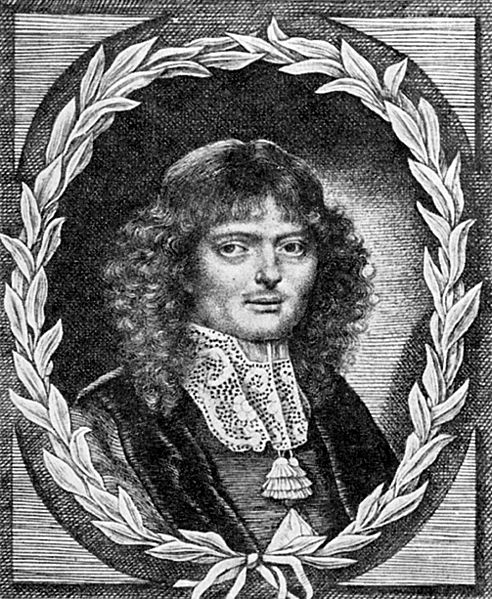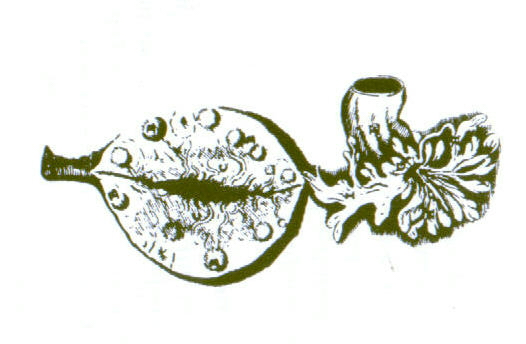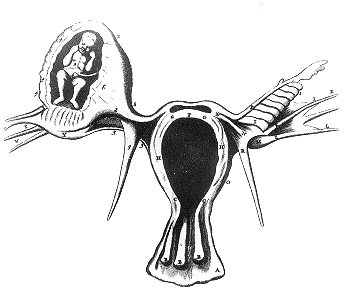<Back to Index>
- Anatomist Regnier de Graaf, 1641
- Author Emily Jane Brontë, 1818
- Member of the Reichstag Eugen Richter, 1838
PAGE SPONSOR

Regnier de Graaf, Dutch spelling Reinier de Graaf or latinized Reijnerus de Graeff (30 July 1641 – 17 August 1673) was a Dutch physician and anatomist who made key discoveries in reproductive biology. His first name is often spelled Reinier or Reynier.
De Graaf was born in Schoonhoven. He studied medicine in Utrecht and Leiden. There his co-students were Jan Swammerdam, Niels Stensen and Frederik Ruysch, one of their professors was Franciscus Sylvius. (All of them were interested in the organs of procreation). He submitted his doctoral thesis on the pancreas, and went to France where he obtained his medical degree from the University of Angers. While in Paris, he also turned to the study of the male genitalia, which led to a publication in 1668. Back in the Netherlands in 1667, De Graaf established himself in Delft. Since he was a Catholic in a mainly Protestant country, he was unable to follow a university career. After the early death of a son, De Graaf died in 1673 at age 32 and was buried in the Oude Kerk in Delft. The reason for his death is unknown; he was, however, affected by his controversy with Swammerdam and the death of his son. Recent speculation that he may have committed suicide is entirely unfounded. A few months before his death De Graaf recommended, as a member of the Royal Society in London, that attention be paid to Antonie van Leeuwenhoek and his work on the improvement of the microscope.
De Graaf's position in the history of reproduction is unique, summarising the work of anatomists before his time, but unable to benefit from the advances about to be made by microscopy, although he reported its use by Antonie van Leeuwenhoek in 1673. His personal contributions include the description of testicular tubules, the efferent ducts, corpora lutea and to describe the function of the Fallopian tubes and hydrosalpinx. De Graaf may have been the first to understand the reproductive function of the Fallopian tube, described the hydrosalpinx, linking its development to female infertility. De Graaf also invented a practical syringe, described in his third treatise.
His eponymous legacy are the Graafian (or ovarian) follicles. He himself pointed out that he was not the first to describe them, but described their development. From the observation of pregnancy in rabbits, he concluded that the follicle contained the oocyte, although he never observed it. The mature stage of the ovarian follicle is called the Graafian follicle in his honour, although others, including Fallopius, had noticed the follicles previously (but failed to recognize its reproductive significance). The term Graafian follicle followed the introduction of the term ova Graafiana by Albrecht von Haller who like De Graaf still assumed that the follicle was the oocyte itself, although De Graaf realised the ovum was much smaller. The discovery of the human egg was eventually made by Karl Ernst von Baer in 1827. De Graaf's contemporary Jan Swammerdam confronted him after his publication of De Mulierum Organis Generatione Inservientibu and accused him of taking credit of discoveries he and Johannes van Horne had made earlier regarding the importance of the ovary and its eggs. De Graaf issued a rebuttal but was affected by the accusation.
De Graaf described female ejaculation and referred to an erogenous zone in the vagina that he himself linked with the male prostate; later this zone was rediscovered by the German gynecologist Ernst Gräfenberg as the G-spot. Further, he described the anatomy of the testicles and collected secretions of the gall bladder and the pancreas.
Despite his contributions, De Graaf made a number of errors in addition to believing that the ovum was the follicle. He never actually consulted the ancient texts but merely repeated the accounts of others compounding their inaccuracies. Because he observed rabbits rather than humans, he assumed fertilisation took place in the ovary. He believed that the seminal vesicles stored spermatozoa.

